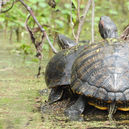
WESTERN CHICKEN TURTLE (Deirochelys reticularia miaria), (SCHWARTZ, 1956)
IDENTIFICATION: 4-10 inches (10-25.4 cm). When viewed dorsally, the carapace is pear-shaped with the widest part just above the rear legs. The carapace contains numerous longitudinally oriented shallow ridges. The vertebral scutes are broad and the first comes into contact with four marginal scutes. This condition is not found among any other aquatic turtles in Texas. The plastron is yellow with some dark markings. The bridge is well developed is marked by 3-4 dark spots above a dark line extending the length of the lower bridge. A broad yellow stripe is present on the front of the forelimbs and the thighs are marked with distinctive vertical yellow stripes. The striped neck is longer than any other species of emydid turtle and can be more than 75-80% the shell length.
BEHAVIOR AND ECOLOGY: This aquatic turtle is fond of basking and within its range can be found in bodies of freshwater with soft bottoms and aquatic vegetation including: lakes, oxbows, swamps, marshes and ephemeral bodies of water such as flooded forest. Juvenile chicken turtles are carnivorous but shift towards an omnivorous diet as they reach maturity.
Females dig a nest approximately 4 inches deep and may deposit 2-20 leathery oval shaped eggs. Females are known to produce 2-4 clutches of eggs per year. Incubation requires 10-12 weeks. In Texas very little is known about the reproductive habits of this species and the first recorded reproductive data for D. reticularia from Texas was recently published. On 3 April 2018 at 11:26 hours a female D. reticularia was found nesting by Ms. Ginger Falgoust in Texas: Fort Bend County: Fulshear. 29°42’26.04”N, 95°54’17.06”W. A total of 12 eggs were laid with mean dimensions of 34 mm X 24 mm. On 7 April 2018 the eggs were gathered from the nest site and incubated in a mixture of vermiculite and pearlite with a relative humidity of 70% at 82° Fahrenheit for 67 days. Seven neonates hatched with mean carapace length x̅ = 32 mm, carapace width x̅ =28.5 mm, plastron length x̅ = 28.5 mm, plastron width x̅ = 22.2 mm, shell height x̅ =15.4 mm and mass x̅ = 9 grams. No sign of embryonic development was present in the remaining five eggs. On 1 July 2018, the baby turtles were released to the wetland adjacent to the original nest site. (Franklin, et al, 2019).
LITERATURE CITED
Franklin, C J; Bednarski, C; Drake, C & Gladkaya, V; 2019. Deirochelys reticularia miaria (Western Chicken Turtle) Reproduction Herpetological Review 50 (1): 121
Ryberg, Wade A.; Brad D. Wolaver, Heather L. Prestridge, Ben J. Labay, Jon Paul Pierre, Ruth A. Costley, Connor S. Adams, Brandon C. Bowers, and Toby J. Hibbitts 2017. Habitat Modeling and Conservation of the Western Chicken Turtle (Deirochelys reticularia miaria) Herpetological Conservation and Biology 12 (2). Link for article: http://www.herpconbio.org/Volume_12/Issue_2/Ryberg_etal_2017.pdf








